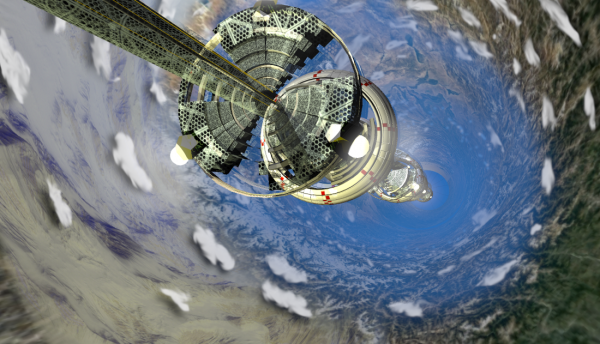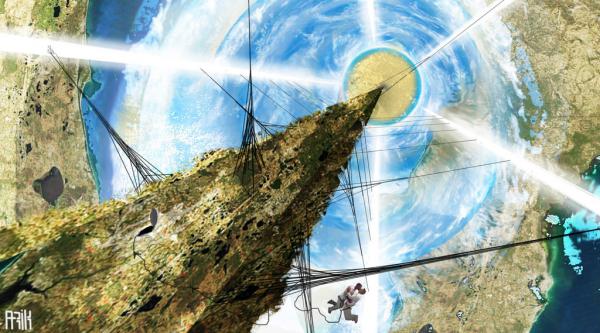BY LETTER
Intra-habitats
Technology > Application > Envirotech
Technology > Application > Infrastructure
Technology > Application > Megascale Engineering
Technology > Application > Infrastructure
Technology > Application > Megascale Engineering
Space habitats often consist of large open spaces with habitable surface on the inner walls. These empty spaces often contain smaller habitats that utilize the existing space in an efficient manner.
Levels: Nested cylinders or spheres within a rotating habitat, creating multiple levels of habitation within a single hab. These may rotate in the opposite direction from the outermost shell, an arrangement which can improve the stability of the structure as a whole. If counter-rotating levels are included they must be separated by at least 50km of near-vacuum.
Plates: Similar to a Level but smaller, these large plates of habitable area are suspended 'inside and above' the outer hull of a hab, but do not form a complete interior structure. Instead, they are surrounded by open space on all sides. Elevators or flyers are used to travel between the Plate and the rest of the habitat. There may be multiple layers of plates at different levels and those in larger habs may be roofed over or air walled if above the outer hull atmosphere. In the bigger habitats, Plates can be the size of a large island or small continent in their own right.
Ledges: Similar to Plates, Ledges are attached to the end caps or side/interior walls of habitat cylinders, rings, or disks. Ledges may be placed on the interior or exterior of a habitat and at practically any distance (and therefore gravity level) from the axis of rotation. They may be structured as a single level, multiple stepped levels (connected or not), or arcs or spirals with spin-generated gravity varying continuously along their length. The majority of Ledges are significantly longer than they are wide, although there are occasional exceptions. Ledge width can range from several meters to several thousand kilometers while their length may be anything up to hundreds of millions of kilometers, depending on the size of the supporting structure.
Ledges placed above the interior atmospheric level or on the hab exterior may be enclosed or airwalled to maintain an atmosphere (which may or may not match that of the rest of the hab) or operate in vacuum. Ledge uses include (but are not limited to) low pressure or vacuum-based habitation, manufacturing, agriculture, biosphere preservation, and recreational activities.
Spokes: Large interior spokes leading from the habitat floor up to the hub. They may be honeycombed with chambers and/or lined with exterior balconies, each up to tens of km across and supporting miniature ecosystems, full-scale cities, or related creations.
Struts: Similar to Spokes except that instead of running to the hub they run at right angles to the hab floor. An array of Struts may form a geometric shape (triangles, squares, pentagons, hexagons, etc.) inside the circle of the hab cylinder. Individual Struts may be hundreds of meters or even several kilometers wide, tens or hundreds of km long, and support ecosystems and population centers on both their upper and lower surfaces.
Lines: Carbon fiber (or even magcarbon reinforced) wound cables hundreds of meters or even several kilometers across which run from the hub to the habitat floor or simply connect different regions of the hab floor, like Struts. These may support high altitude and hanging structures and ecosystems of various kinds.
Walls: Some habitats will split up their interior volume using large walls that are themselves honeycombed with huge enclosed chambers. Walls resemble diskworlds in many ways, but they often have openings or airlocks to allow the passage of flying craft.
Hanging Ecosystems: Vacuum dwelling Hanging Ecosystems can be found on the underside of Banks Orbitals or Bishop Rings or any sufficiently large hab exterior. These, and air-living variants, can be found attached to shellworld roofs, the undersides of Levels, Plates, Ledges and Struts, roofs of supra-planetary or supra-stellar shells, and other similar locations.
Chandeliers: Cities or other structures that hang from the 'ceiling' of a shellworld or other multi-level habitat. They can be quite large, often several tens of kilometers across, and supported by multiple buckyfiber cables. They are often also located near the zero-G hub or the in lower gravity areas of a spinning hab.
Free-floating Interior Habs: These are small to full size habs, freespheres, orwoods, asteroids, comets, etc suspended in the freefall interior of a large hab. Such structures must be decoupled from the spin of the hab and are often anchored to the hub for safety.
Freefall Atmospheres and Oceans: Large bodies of air and/or water may be placed in the freefall center of a hab, wrapped in a membrane to provide containment, and actively stabilized. These can host their own ecosystems, often dwarfing mere planetary scale biomes in their size and complexity.
Lighting Rigs: Intra-habitats may be illuminated using mirrors and light-guides, or via active lighting. Sunclouds are one example of this. Many kinds of intra-habitat structures can emit light actively so they do not shade the landscape underneath.
 Image from Steve Bowers | |
| Morrow Habitat has a complex internal hub structure, which once held a thriving population. | |
Related Articles
Appears in Topics
Development Notes
Text by Todd Drashner
Initially published on 29 July 2013.
Ledges Section added by Todd Drashner February 2023
Initially published on 29 July 2013.
Ledges Section added by Todd Drashner February 2023








